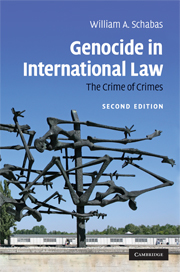Book contents
- Frontmatter
- Contents
- Preface to the first edition
- Preface to the second edition
- Acknowledgments
- List of abbreviations
- Introduction
- 1 Origins of the legal prohibition of genocide
- 2 Drafting of the Convention and subsequent normative developments
- 3 Groups protected by the Convention
- 4 The physical element or actus reus of genocide
- 5 The mental element or mens rea of genocide
- 6 ‘Other acts’ of genocide
- 7 Defences to genocide
- 8 Prosecution of genocide by international and domestic tribunals
- 9 State responsibility and the role of the International Court of Justice
- 10 Prevention of genocide
- 11 Treaty law questions and the Convention
- Conclusions
- Appendix: The three principal drafts of the Convention
- Bibliography
- Index
Preface to the first edition
Published online by Cambridge University Press: 07 July 2009
- Frontmatter
- Contents
- Preface to the first edition
- Preface to the second edition
- Acknowledgments
- List of abbreviations
- Introduction
- 1 Origins of the legal prohibition of genocide
- 2 Drafting of the Convention and subsequent normative developments
- 3 Groups protected by the Convention
- 4 The physical element or actus reus of genocide
- 5 The mental element or mens rea of genocide
- 6 ‘Other acts’ of genocide
- 7 Defences to genocide
- 8 Prosecution of genocide by international and domestic tribunals
- 9 State responsibility and the role of the International Court of Justice
- 10 Prevention of genocide
- 11 Treaty law questions and the Convention
- Conclusions
- Appendix: The three principal drafts of the Convention
- Bibliography
- Index
Summary
The legal questions involved in studying genocide draw on three areas of law: human rights law, international law and criminal law. These are all subjects that I have both taught and practised. This alone ought to be sufficient to explain my interest in the subject. But there is more. Of the three great genocides in the twentieth century, those of the Armenians, the Jews and Gypsies, and the Tutsi, my life has been touched by two of them.
My grandparents on my father's side, and my ancestors before them for generations, came from Kosowa and Brzezany, towns in what was once called Eastern Galicia. Located in the general vicinity of the city of Lvov, they are now part of Ukraine. Essentially nothing remains, however, of the Jewish communities where my grandparents were born and raised. In the months that followed the Nazi invasion of the Soviet Union, the Einsatzgruppen murdered as many as two million Jews who were caught behind the lines in the occupied territories. On 16–17 October 1941, in a German Aktion, 2,200 Jews, representing about half the community of Kosowa, were taken to the hill behind the Moskalowka bridge and executed. Parts of the population of both towns, Brzezany and Kosowa, were deported to the Belzec extermination camp. As the Germans were retreating, after their disastrous defeat at Stalingrad in January 1943, the executioners ensured they would leave no trace of Jewish life behind.
- Type
- Chapter
- Information
- Genocide in International LawThe Crime of Crimes, pp. ix - xiiPublisher: Cambridge University PressPrint publication year: 2009



